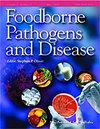Phylogenetic Analysis Based on Whole Genome Sequences, Antibiotic Resistance, and Virulence of Salmonella enterica Clinical Isolates from South Korea.
IF 1.9
2区 农林科学
Q3 FOOD SCIENCE & TECHNOLOGY
引用次数: 0
Abstract
Salmonella is a major cause of foodborne disease and frequently causes human salmonellosis in South Korea. In this study, we investigated the genome diversity, antimicrobial resistance, and virulence of clinical isolates of Salmonella enterica from South Korea. We collected 42 S. enterica subsp. enterica isolates from two hospitals in South Korea. Whole genome sequences were determined. Serovars and sequence types (STs) based on multilocus sequence typing (MLST) were identified from whole genome sequences. Phylogenetic trees based on whole genome sequences and a minimum spanning tree based on MLST were constructed. Human serum resistance assays and gentamicin protection assays were performed to assess in vitro virulence. Nineteen serovars were identified among 42 clinical isolates, including nine Salmonella Typhi isolates. There were inconsistencies between serogroups and phylogenetic clusters in the phylogenetic tree and minimum spanning tree, but high clonality of S. Typhi was observed. Salmonella Typhi isolates were divided into two clusters, corresponding to ST1 and ST2. Isolates of serovars Typhimurium and I4,[5],12:i:- clustered into a group, and a hybrid isolate between the two serovars was identified. Four ciprofloxacin-resistant isolates were identified among nine S. Typhi isolates, and all isolates of S. Enteritidis and S. Panama were resistant to colistin. The gentamicin protection assay revealed that serogroup D1 was significantly less virulent than the other serogroups. Our study suggests high diversity of S. enterica clinical isolates from South Korea and non-monophyly of serogroups. In addition, subgroups of S. Typhi isolates and a hybrid isolate between serovars Typhimurium and I4,[5],12:i:- were identified.基于全基因组序列、抗生素耐药性和韩国肠炎沙门氏菌临床分离菌毒力的系统发育分析。
沙门氏菌是食源性疾病的主要致病菌,在韩国经常引起人类沙门氏菌病。在这项研究中,我们调查了韩国肠炎沙门氏菌临床分离株的基因组多样性、抗菌药耐药性和毒力。我们从韩国两家医院收集了 42 个肠炎沙门氏菌亚种分离株。测定了全基因组序列。根据全基因组序列确定了血清型和基于多焦点序列分型(MLST)的序列类型(ST)。构建了基于全基因组序列的系统发生树和基于 MLST 的最小跨度树。进行了人血清耐药性测定和庆大霉素保护测定,以评估体外毒力。在42个临床分离株中鉴定出19个血清型,其中包括9个伤寒沙门氏菌分离株。在系统发生树和最小跨度树中,血清群和系统发生群之间存在不一致,但观察到伤寒沙门氏菌的克隆性很高。伤寒沙门氏菌分离物分为两个群,分别对应于 ST1 和 ST2。Typhimurium 和 I4,[5],12:i:-血清分离物聚为一组,并鉴定出这两种血清之间的杂交分离物。在 9 个伤寒杆菌分离株中发现了 4 个对环丙沙星耐药的分离株,肠炎双球菌和巴拿马双球菌的所有分离株都对可乐定耐药。庆大霉素保护试验显示,血清 D1 群的毒性明显低于其他血清群。我们的研究表明,韩国的肠道病毒临床分离株具有很高的多样性,而且血清群之间没有单系。此外,还发现了 Typhimurium 和 I4、[5]、12:i:- 血清分离物的亚群和一个杂交分离物。
本文章由计算机程序翻译,如有差异,请以英文原文为准。
求助全文
约1分钟内获得全文
求助全文
来源期刊

Foodborne pathogens and disease
医学-食品科技
CiteScore
5.30
自引率
3.60%
发文量
80
审稿时长
1 months
期刊介绍:
Foodborne Pathogens and Disease is one of the most inclusive scientific publications on the many disciplines that contribute to food safety. Spanning an array of issues from "farm-to-fork," the Journal bridges the gap between science and policy to reduce the burden of foodborne illness worldwide.
Foodborne Pathogens and Disease coverage includes:
Agroterrorism
Safety of organically grown and genetically modified foods
Emerging pathogens
Emergence of drug resistance
Methods and technology for rapid and accurate detection
Strategies to destroy or control foodborne pathogens
Novel strategies for the prevention and control of plant and animal diseases that impact food safety
Biosecurity issues and the implications of new regulatory guidelines
Impact of changing lifestyles and consumer demands on food safety.
 求助内容:
求助内容: 应助结果提醒方式:
应助结果提醒方式:


